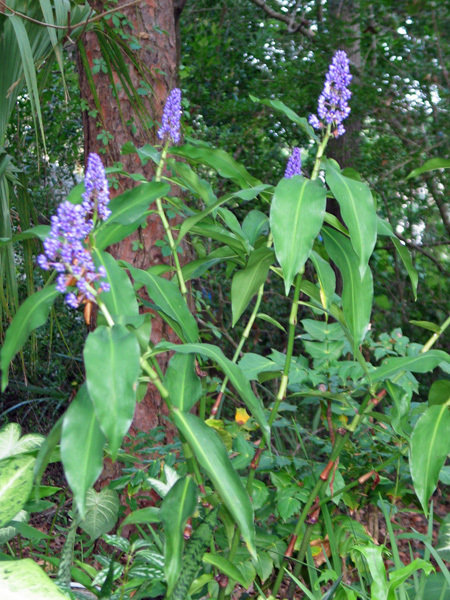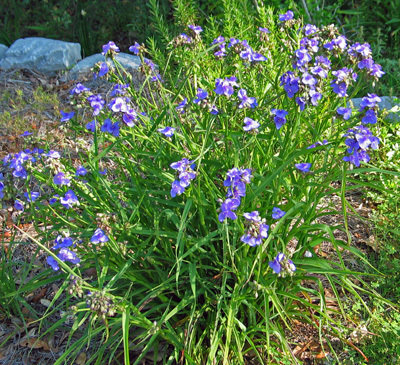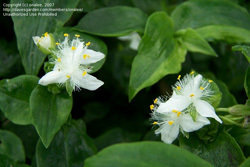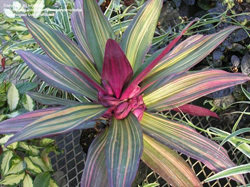





The wandering Jew or spiderwort family (Commelinaceae) consists of 41 accepted genera (APG III) and several hundred species. Many of them are cultivated ornamentals, but others are landscape thugs that we avoid and attempt to banish from our gardens.
Spiderwort family members have several traits in common. All are monocots, or flowering plants that have one seed leaf, flower parts in threes, and parallel veining. The ephemeral flowers lack nectar and last only a few hours in most cases. They are rather fleshy plants that often have a mucilaginous, or slimy sap, giving it a common name of snotweed. On exposure to air, this slimy substance dries to form a weblike mass, giving credence to the common name "spiderwort."
The White Sheep of the Family
 Like many other plant families, some members of the spiderwort family are well behaved garden plants that add just the right element to our gardens. A very popular landscape plant is blue ginger (Dichorisandra thyrsiflora). Obviously, being called a ginger does not make it so. Blue ginger is a member of the spiderwort family that produces stalks of evergreen perennial foliage in tropical areas. Erect, rhizomatous, soft-stemmed plants are native to the tropical woodlands of North, Central and South America. Stems are hardy in Zones 10-11 and protected places in Zone 9. The stems come back each spring from the rhizomes in Zone 8. The tall, fleshy stems grow to 8 feet tall and produce dense spikes of brilliant blue flowers. Blue ginger is easily propagated from division of rhizomes. Another easy means of increase is from cuttings of the stalks. When placed horizontally in a light potting mix, new plants arise at each joint.
Like many other plant families, some members of the spiderwort family are well behaved garden plants that add just the right element to our gardens. A very popular landscape plant is blue ginger (Dichorisandra thyrsiflora). Obviously, being called a ginger does not make it so. Blue ginger is a member of the spiderwort family that produces stalks of evergreen perennial foliage in tropical areas. Erect, rhizomatous, soft-stemmed plants are native to the tropical woodlands of North, Central and South America. Stems are hardy in Zones 10-11 and protected places in Zone 9. The stems come back each spring from the rhizomes in Zone 8. The tall, fleshy stems grow to 8 feet tall and produce dense spikes of brilliant blue flowers. Blue ginger is easily propagated from division of rhizomes. Another easy means of increase is from cuttings of the stalks. When placed horizontally in a light potting mix, new plants arise at each joint.
Another popular landscape plant from the family is purple heart (Tradescantia pallida), or setcreasea. This plant is a hardy groundcover for Zones 8-11. In areas outside its hardiness range, it is a popular plant for containers and hanging baskets. This Mexican native prefers rich, well-drained soils, but is widely adapted to a range of soils. Best growth and richest color is in full sun, but it is tolerant of some shade. Although purple heart prefers ample moisture, it does well in dry soil and is often included on lists of drought tolerant plants. This workhorse of a plant can tolerate a touch of frost, but freezing weather will send the top growth to the ground. New plants emerge from the roots come spring. Like other members of the family, purple heart is easy to propagate from cuttings or division, and is very easy to transplant.
Virginia spiderwort (Tradescantia virginiana) is a native plant that people tend to either love or hate. Present in the entire eastern half of the United States as well as Ontario, many consider it a favorite garden plant. The characteristic three-petaled flowers last only a day, but each stalk has a large cluster of buds that open in succession and bloom most of the summer. They continue to bloom when cut and placed in water. Several named cultivars are available with flowers in colors of blue, lavender, and shades of pink to red. While Virginia spiderwort is pretty enough blooming in colonies along the interstates, it can self-sow and become a nuisance in the garden.
The Black Sheep of the Family
 At the other end of the spectrum are the landscape thugs that become invasive and spread into areas where they have an adverse impact on native plant and animal communities. One such unwanted noxious plant is Tradescantia fluminensis (green wandering Jew). Hailing from subtropical regions of Argentina and Brazil, this pretty green vine is extremely invasive and difficult to control. It is listed as a Category I invasive exotic species on the Florida Exotic Pest Plant Council (FLEPPC) list. Some cultivars are available that may be less vigorous, but caution is advised because they can revert to solid green and become invasive. Attractive cultivars such as ‘Variegata', ‘Quicksilver' and ‘Maiden's Blush' are often grown, but they bear watching.
At the other end of the spectrum are the landscape thugs that become invasive and spread into areas where they have an adverse impact on native plant and animal communities. One such unwanted noxious plant is Tradescantia fluminensis (green wandering Jew). Hailing from subtropical regions of Argentina and Brazil, this pretty green vine is extremely invasive and difficult to control. It is listed as a Category I invasive exotic species on the Florida Exotic Pest Plant Council (FLEPPC) list. Some cultivars are available that may be less vigorous, but caution is advised because they can revert to solid green and become invasive. Attractive cultivars such as ‘Variegata', ‘Quicksilver' and ‘Maiden's Blush' are often grown, but they bear watching.
 Another exotic invasive Tradescantia is Moses-in-a-boat, or oyster plant (T. spathacea). Native to the West Indies, Mexico and Central America, this pretty plant has escaped cultivation in Louisiana and Florida. It, too, is listed as Category I by the FLEPPC. Wind-dispersed seeds sprout in all sorts of places-even as epiphytes on city buildings. In Zones 9-11 where oyster plant is hardy, the ecological problems exist in places where it has invaded hardwood hammock forests. In these places, it can create a dense groundcover that prevents native plants from germinating.
Another exotic invasive Tradescantia is Moses-in-a-boat, or oyster plant (T. spathacea). Native to the West Indies, Mexico and Central America, this pretty plant has escaped cultivation in Louisiana and Florida. It, too, is listed as Category I by the FLEPPC. Wind-dispersed seeds sprout in all sorts of places-even as epiphytes on city buildings. In Zones 9-11 where oyster plant is hardy, the ecological problems exist in places where it has invaded hardwood hammock forests. In these places, it can create a dense groundcover that prevents native plants from germinating.
Knowing as much about the plants you add to your garden pays dividends sooner or later. Choose wisely, and avoid the exotic invasive plants so that you and the spiderwort family members that you invite can coexist peacefully on your piece of ground.
Thanks to kniphofia for the image of Moses-in-a-boat, and to onalee for the image of white-flowering wandering Jew.
Copyright © www.100flowers.win Botanic Garden All Rights Reserved